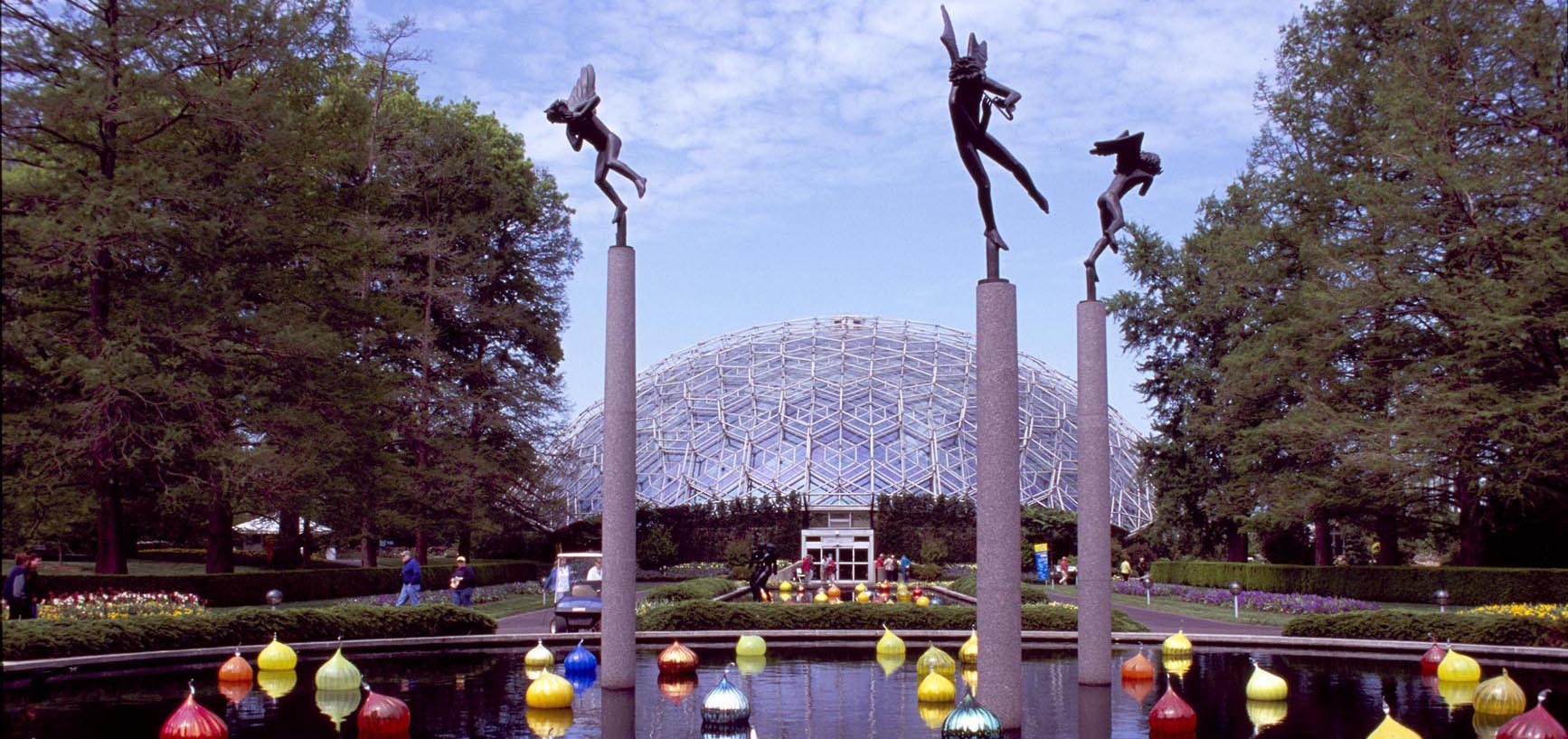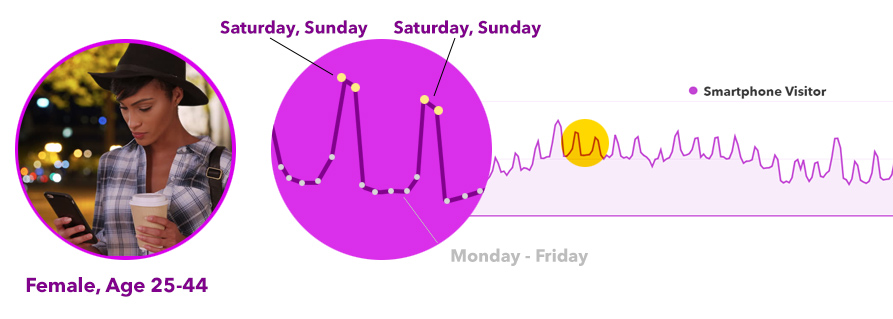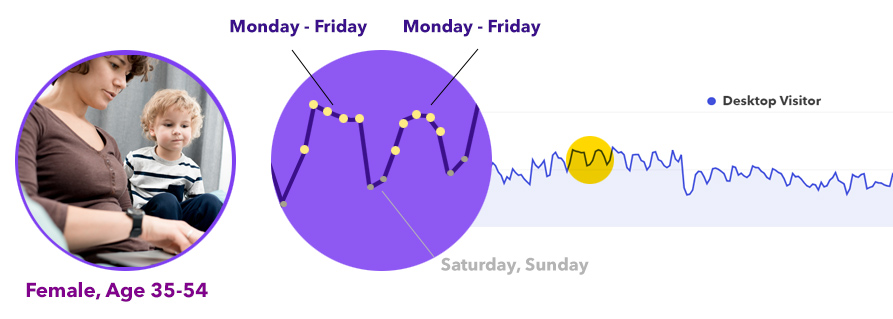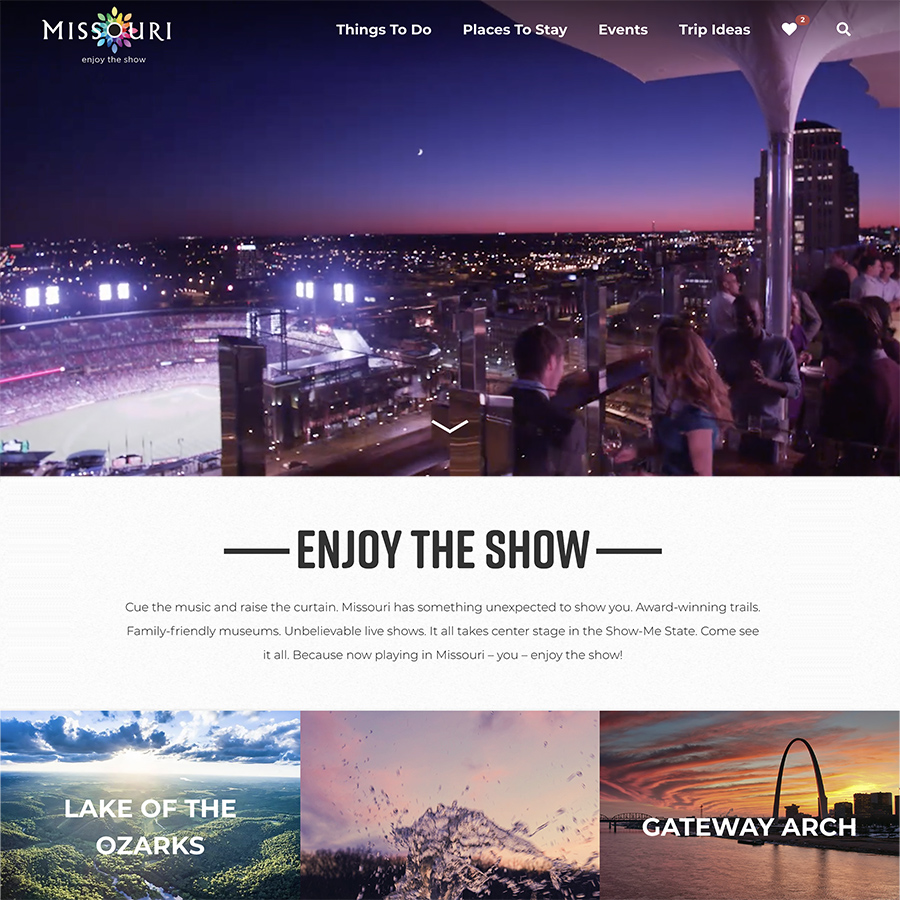Meet the new Missouri Tourism website – www.VisitMO.com
In 2017, H/L was awarded digital agency of record for the Missouri Division of Tourism and immediately began planning a new state-of-the-art tourism website. It launched in March and the results are already impressive – and quite intriguing. H/L discovered two distinct groups of consumers that were important to Missouri’s tourism model. The challenge was to create a single site that could dynamically shift its content to maximize its appeal for two targets using the four key factors that helped identify who was who: device used, geographic location, day of week, and of course – personal preference.
When planning began, years of online consumer data was reviewed to determine which behaviors were predictable over time and which behaviors showed a shift or trend. It was not unusual to see a year over year climb in smartphone adoption. What is interesting though is that for the last three years, the dominant device for visitors was the desktop. In May of 2017, the split was 60/40 with the latter being smartphone audience. Towards the end of July that year, smartphone users eclipsed desktop users for the first time by a slim margin of 51% to 49%.

Photo: The Missouri Botanical Gardens
While the mantra “mobile first” was pervasive throughout the digital marketing universe, H/L still had a responsibility to take a hard look at the core consumers and decide if one approach over another was correct. Turns out, two approaches were necessary. Here’s why:
Content that Compels.
The desktop visitor desires inspiration.
The desktop visitor was older, had more discretionary income and was planning not for themselves but for their family. It makes sense. You’re sitting down, getting comfortable with your laptop and you begin exploring ideas for the most awesome vacation – comparing locations, lodging, trip ideas, density of attractions, reviews, etc. These visitors are prepared to open multiple windows, spending time going back and forth. This person wants a website that gives them an amazing window-shopping experience. They don’t know what they want yet and are ready and willing to be “wowed”. The new VisitMO.com website made delivering on that wow a priority. Once the visitor is drawn in, the site backs it up with additional suggestions based on the interest type, provides reviews and other pre-packaged trip ideas. The planner of the trip wants guarantees that they can put together a trip that will be cherished. And they need proof. They may want the steak but you really need to give them the sizzle, too.
Information that Empowers.
The smartphone visitor wants answers. Now.
The smartphone users were younger and were out and about. A lot. Year over year, as smartphone visitation grew, their online behavior did not. Predictive patterns showed they preferred the search utility. Or they browsed Events. They consumed the same amount of pages as their desktop counterparts, but in half the time. This was a visitor that wanted specific information for quick trips (or while in-trip) and was using the website as an informational resource to improve and build on the intent they had already established. This meant the new website had to deliver information based on geo-location and offer suggestions for complementary (but not competing) activities. Relevance and speed are key. Don’t deliver on these aspects and the modern, young tourist will ditch the site and not come back.

Photo: The Lake of the Ozarks
Two strategies. Solved with one website.
It was clear that the new VisitMO.com had to do more than have a “mobile first” approach with these two consumer profiles being equally important for a thriving tourism economy. A custom algorithm was deployed to control the types of content being shown. While the site is clearly visually responsive (meaning it looks really nice no matter what device you use) it has taken a much farther step – and is content responsive. The algorithm looks at your location and matches it up with your device. Smartphone users are served content that is given a higher weight to events and attractions and which appeal to those age 25 to 44. Desktop users are served up content that is more conducive to long-term trip planning, lodging, family fun and attractions that appeal to users in the age group of 35 to 54.
Visits during the weekend have the algorithm giving higher weights to events and shows (as they are perishable / time sensitive) and visits during the week have the site prioritizing content that has wider group appeal with little or no time expiration – as desktop users have been proven to dominate the site Monday through Friday and are looking at longer-term, and more substantial, vacation plans. All of this is calculated on the first visit, as the database has little else to go on except these pre-established rules that were based on researched behavior. Once the visitor begins interacting with the site, the types of content consumed are recorded and averaged with other visited pages so that the website customizes itself based on a profile it is constantly refining. Each subsequent visit to the site becomes more and more relevant. More personalized.
Taking a look at traffic patterns to uncover user behavior.

The graphic above shows website traffic, day in, day out. The tell-tale sawtooth pattern told us that there was repeatable and consistent user behavior. This was potentially exciting news as it might reveal a key insight. As marketers, we leverage repeatable behavior by predicting what type of messaging the consumer will respond to and when. What we noticed was that the spikes (increases in daily traffic to the website) were a different shape between smartphone and desktop visitors. The troughs (decreases in daily traffic) were different as well. Was there a story there? Why yes, there was.
Proof of a dual audience, revealed by Day of Week.

Zooming in reveals that spikes in traffic on Saturday and Sunday is largely due to the smartphone visitor and they drop off significantly on weekdays. These people are younger and are looking for information quickly to enhance their day plans. Site search, relevant results and speed are critical.

Looking closer at the desktop user, it’s fascinating to see the opposite. Spikes in traffic happen consistently from Monday through Friday and drop off on the weekends. The desktop user is looking for amazing places to go and needs guidance and suggestions. Put your best content forward, give them compelling reasons and reward them for browsing around. They are not in a hurry, but they don’t want their time wasted either.

Enjoy the Show. Check out the website for yourself.
Results
While the new site has only been live for less than two months, the results tell quite the story – with more than 100 thousand additional visitors than the previous year at this time and those visitors reading more than 662,000 pages collectively. The dual-strategy pays off, with analytics proving that visitors in the 25-44 age range prefer to visit via smartphone and are using site search to find information quickly. And – as predicted – consuming the same amount of pages as desktop users but with twice the speed. Side note: this is something to keep in mind if you are using Time On Site as a KPI. H/L is beginning to recommend speed as a KPI for smartphone users (low TOS). Conversely, we are pushing for higher TOS as a KPI for desktop users. As expected, those desktop users spend twice as much time per visit on average and seek out exploratory topics such as Things To Do, Lodging, and Trip Ideas.
Here’s one of the more intriguing aspects of the new site launch: 75% of visitors in the last 6 weeks are smartphone users. This is a drastic spike in mobile usage that bucks the trend of the last few years which only showed a stable and steady rise. This 25% increase is being evaluated at the moment and it looks like social channels have had a larger impact on tourism traffic than in previous years. We will continue to monitor the traffic statistics and develop an explanation around causality.
H/L is proud to have worked alongside the marketing staff at the Missouri Division of Tourism. The goal was to deliver a rich, online experience to inspire people to choose a wonderful Missouri vacation. Missouri, as always, will certainly deliver on that promise. Enjoy the show.
